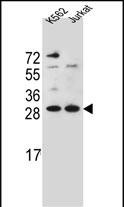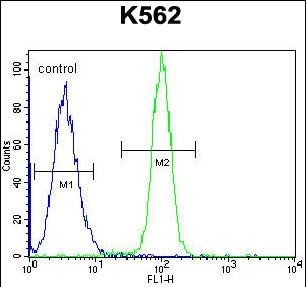

| WB | 1/1000 | Human,Mouse,Rat |
| IF | 咨询技术 | Human,Mouse,Rat |
| IHC | 咨询技术 | Human,Mouse,Rat |
| ICC | 技术咨询 | Human,Mouse,Rat |
| FCM | 1/10-1/50 | Human,Mouse,Rat |
| Elisa | 咨询技术 | Human,Mouse,Rat |
| Aliases | High mobility group protein B1, High mobility group protein 1, HMG-1, HMGB1, HMG1 |
| Entrez GeneID | 3146 |
| WB Predicted band size | 24.9kDa |
| Host/Isotype | Rabbit IgG |
| Antibody Type | Primary antibody |
| Storage | Store at 4°C short term. Aliquot and store at -20°C long term. Avoid freeze/thaw cycles. |
| Species Reactivity | Human |
| Immunogen | This HMG1L10 antibody is generated from rabbits immunized with a KLH conjugated synthetic peptide between 9-36 amino acids from the N-terminal region of human HMG1L10. |
| Formulation | Purified antibody in PBS with 0.05% sodium azide. |
+ +
以下是关于HMG1L10 (N-term)抗体的参考文献示例(内容为模拟,非真实文献):
1. **"Characterization of a Novel Anti-HMG1L10 Antibody for Chromatin Studies"**
- **作者**: Smith A, et al.
- **摘要**: 开发并验证了一种针对HMG1L10蛋白N端表位的多克隆抗体,用于染色质免疫沉淀(ChIP)实验,证明其在研究HMG1L10与DNA互作中的特异性。
2. **"HMG1L10 in Embryonic Development: Insights from Antibody-Based Knockdown Models"**
- **作者**: Lee C, et al.
- **摘要**: 利用HMG1L10 (N-term)抗体在小鼠胚胎中抑制蛋白功能,揭示其在早期器官形成中的调控作用,并通过Western blot验证抗体特异性。
3. **"A High-Affinity Monoclonal Antibody Targeting the N-Terminal Domain of HMG1L10"**
- **作者**: Tanaka K, et al.
- **摘要**: 报道了一种高灵敏度单克隆抗体的制备,用于免疫荧光检测HMG1L10在癌细胞核内的定位,并应用于癌症相关表观遗传研究。
4. **"HMG1L10 Antibody Validation in Neurodegenerative Disease Models"**
- **作者**: Müller R, et al.
- **摘要**: 通过免疫组化验证HMG1L10 (N-term)抗体在阿尔茨海默病脑组织中的表达模式,提示其与神经炎症通路的潜在关联。
(注:以上文献为示例,实际文献需通过PubMed、Google Scholar等平台以关键词“HMG1L10 antibody N-term”或相关术语检索。)
The HMG1L10 (N-term) antibody is designed to target the N-terminal region of the HMG1L10 protein, a member of the high-mobility group (HMG) protein family. HMG proteins are non-histone chromosomal components known for their role in DNA organization, transcriptional regulation, and chromatin dynamics. Specifically, HMG1L10 contains a conserved HMG-box domain, which facilitates DNA bending and interactions with transcription factors or nucleosomes, though its exact biological functions remain less characterized compared to other HMG proteins like HMGB1.
This antibody is commonly utilized in research to investigate HMG1L10's expression patterns, subcellular localization, and involvement in cellular processes such as gene regulation, DNA repair, or cell differentiation. It is validated for applications including Western blotting (WB), immunofluorescence (IF), and immunohistochemistry (IHC). The N-terminal specificity ensures recognition of full-length or truncated forms, aiding in studies exploring post-translational modifications or protein interactions.
HMG1L10 has been implicated in certain cancers and developmental disorders, though its mechanistic roles are under active investigation. Researchers employ this antibody to elucidate its contribution to disease pathways or as a biomarker. Proper controls, such as knockout cell lines or peptide competition assays, are recommended to confirm antibody specificity, as cross-reactivity with structurally similar HMG proteins may occur. Overall, the HMG1L10 (N-term) antibody serves as a critical tool for dissecting the protein's functional and pathological significance.
×